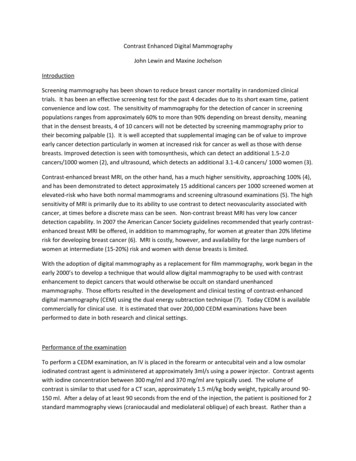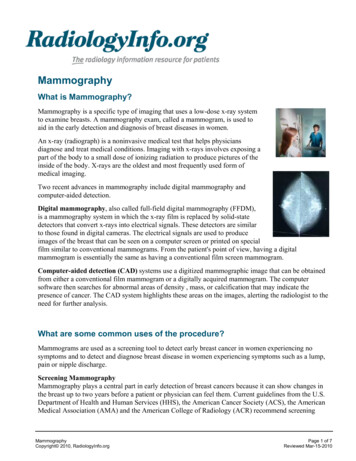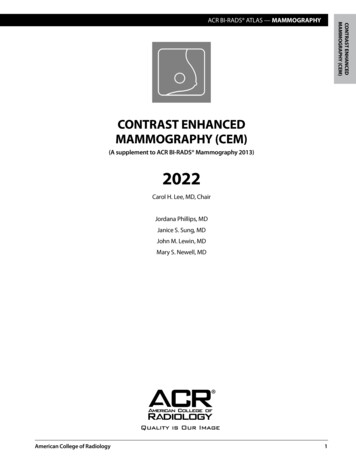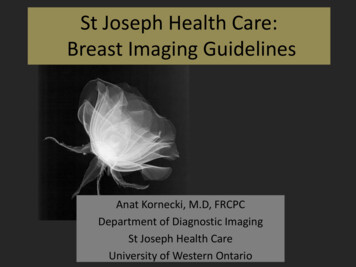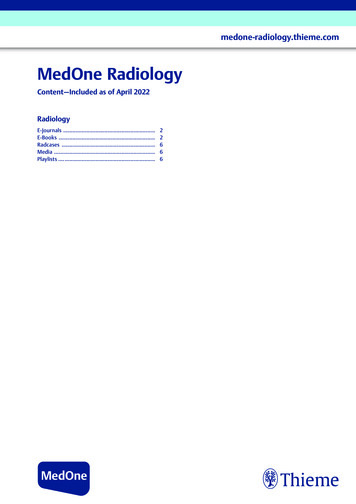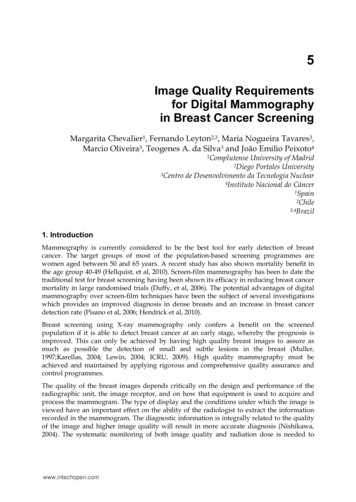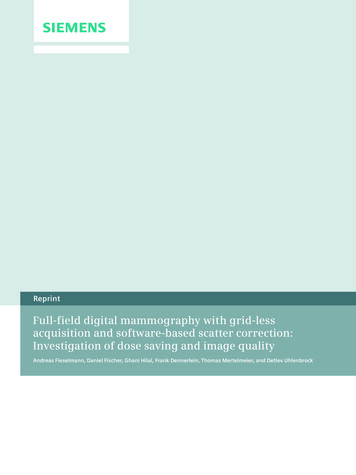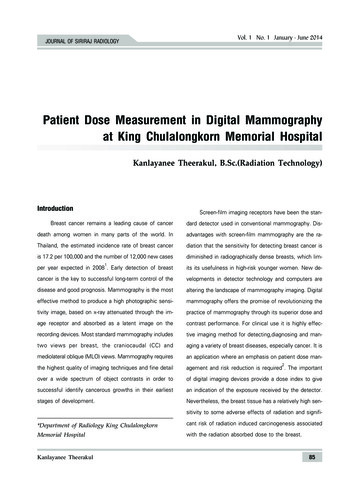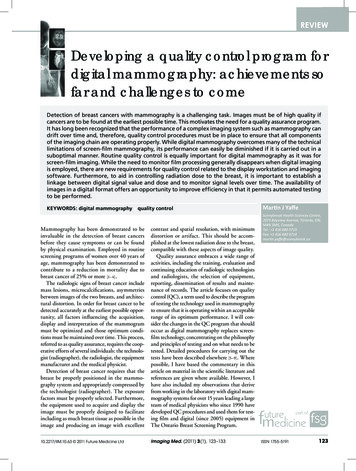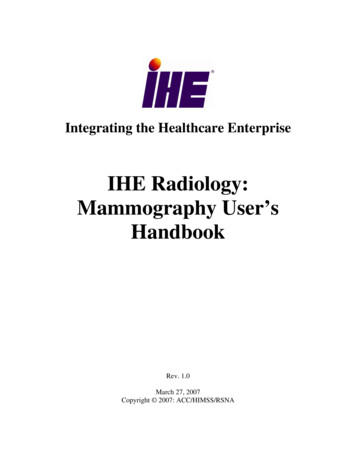
Transcription
Integrating the Healthcare EnterpriseIHE Radiology:Mammography User’sHandbookRev. 1.0March 27, 2007Copyright 2007: ACC/HIMSS/RSNA
IHE Radiology: Mammography User’s Handbook, Rev. 1.0ContributorsEditors: Christoph Dickmann, Nikolaos A. GkanatsiosAuthors.Digital Mammography Modality: Christoph Dickmann, Nikolaos A.Gkanatsios, Michael Jonas, Carolyn Reynolds, Judith Wolfman, Margarita ZuleyMammography Diagnostic Review Workstation: Christoph Dickmann, Nikolaos A.Gkanatsios, Michael Jonas, Carolyn ReynoldsMammography Film Printer: Eliezer Avraham, Nikolaos A. Gkanatsios, RonHitzelbergerNote: This is the first edition of the IHE Radiology: Mammography User’s Handbook.New editions will be available at IHE.net and will include examples of more contractualRFP language, more Profiles (for Radiology, IT Infrastructure, Cardiology, andLaboratory domains), and scenarios for workstations and basic PACS installations.The Handbook is intended to meet the needs of the IHE user community. Feedback onthe contents or suggested additions is welcome on the IHE Forum page atforums.rsna.org.2007-03-271
IHE Radiology: Mammography User’s Handbook, Rev. 1.0Executive SummaryThis handbook has been developed by the IHE Mammography Committee and the IHERadiology Technical and Planning Committees expressly for those who are consideringthe purchase and implementation of digital mammography equipment. The intention ofthis handbook is to make the purchasing and implementation process easier and moresuccessful. Three chapters are currently included herein. Chapter 1 is focused on thepurchase and integration of full field digital mammography modalities. Chapter 2addresses the requirements for successful deployment of a mammography diagnosticreview workstation. Chapter 3 offers details on integrating a mammography film printer.Also included in this handbook are a Glossary and a sample RFP (request for purchase)together with a series of appendixes to provide more details on the planning andpurchasing process of digital mammography equipment. This handbook exists as part ofthe IHE Radiology User’s Handbook. These documents are available online athttp://www.ihe.net/Resources/handbook.cfm.In each chapter you will find sections describing the planning and purchasing process ofdigital mammography equipment. Details are given as to how to select the appropriateIHE integration profiles to make the new equipment integrate seamlessly and becomefully functional in an IHE conforming enterprise. Details as to how to put together RFPs,how to interpret vendor responses to your RFPs and how to select the right product foryour goals and environment are explained.Each chapter also goes over the configuration and implementation process of digitalmammography equipment. Possible workflow scenarios are explained. Details on howto test the main profile requirements that may apply to each piece of equipment areprovided together with information on potential installation and legacy issues.Last but not least, this handbook goes over all relevant profiles that may be necessary foryour new equipment and the benefits your enterprise will experience by adopting suchprofiles. Implementation of the listed profiles for each type of digital mammographyequipment will assure optimal function of the equipment in the heterogeneousenvironments that exist essentially in all facilities.2007-03-272
IHE Radiology: Mammography User’s Handbook, Rev. 1.0ContentsExecutive Summary . 2Introduction. 5How to Use this Handbook . 7Glossary . 81Integration of a Digital Mammography Modality . 111.1The Planning and Purchasing Process of a Digital Mammography Modality. 111.1.1Selecting IHE Integration Profiles for the Digital Mammography Modality121.1.2Selecting IHE Integration Actors on the Digital Mammography Modality151.1.3Specifying Integration Requirements in an RFP . 171.1.4Identifying Suitable Products. 171.1.5Reading Integration Statements from Vendors. 171.2The Configuration and Implementation Process of a Digital MammographyModality. 181.2.1Considering Changes to Your Workflow . 181.2.2Confirming That It Works . 181.2.3Considering Installation Issues . 221.2.4Identifying and Addressing “Legacy” Problems . 262 Integration of a Diagnostic Review Workstation for Mammography Reading andReporting. 282.1The Planning and Purchasing Process of a Mammography Review Workstation282.1.1Selecting IHE Integration Profiles for a Mammography DiagnosticReview Workstation. 292.1.2Selecting IHE Integration Actors on the Mammography DiagnosticReview Workstation. 342.1.3Putting Integration Requirements in Your RFP. 352.1.4Identifying Suitable Products. 362.1.5Reading Integration Statements from Vendors. 362.2The Configuration and Implementation Process of a Mammography DiagnosticReview Workstation. 362.2.1Considering Changes to Your Workflow . 362.2.2Confirming That It Works . 362.2.3Considering Installation Issues . 462.2.4Identifying and Addressing “Legacy” Problems . 503Integration of a Digital Mammography Film Printer. 523.1The Planning and Purchasing Process of a Mammography Film Printer . 523.1.1The IHE Mammography Image Profile as it Applies to a MammographyFilm Printer . 533.1.2Selecting IHE Integration Actors on the Digital Mammography Modality543.1.3Putting Integration Requirements in Your RFP. 543.1.4Identifying Suitable Printers . 553.1.5Reading Integration Statements from Vendors. 552007-03-273
IHE Radiology: Mammography User’s Handbook, Rev. 1.03.2The Configuration and Implementation Process of a Mammography FilmPrinter 55Appendix A Developing an Integration Strategy . 56Appendix B Understanding IHE Integration Profiles . 60Appendix C Writing Integration Capabilities into an RFI/RFP . 62Appendix D Identifying Suitable Products. 64Appendix E Reading Integration Statements . 65Appendix G Obtaining and Reading DICOM Conformance Statements. 66Appendix H Obtaining and Reading HL7 Interface Specifications . 67Appendix I Conducting Acceptance Testing . 68Appendix J Performance Metrics. 702007-03-274
IHE Radiology: Mammography User’s Handbook, Rev. 1.0IntroductionWhat is IHE?Integrating the Healthcare Enterprise (IHE) is an initiative whose goal is to make allnecessary information about any given patient readily available to a care provider inorder to ensure optimal medical care to the patient. This initiative is driven by careproviders (including ACC, HIMSS and RSNA) and vendors. IHE defines IntegrationProfiles that use established IT standards to integrate systems from multiple vendors foreffective interoperability and efficient workflow in day-to-day work scenarios of healthprofessionals (users), using information from patients’ records.This handbook helps you to understand, choose and select IHE integration capabilities forproducts you purchase or upgrade so that the systems will better support your clinicalneeds. It targets users that1. Make decisions on purchasing or maintaining health IT systems (e.g. CIO,Radiologist, Physician),2. Install and administer these systems in an institution (e.g. IT/ Physicianadministrators).What is an Integration Profile?An IHE Integration Profile describes precisely how to solve given real-world clinicalproblems through functional system components, called IHE Actors. These are based onstandards such as Digital Imaging and Communication in Medicine (DICOM) and HealthLevel 7 (HL7). Integration Profiles do not create standards; rather they clearly, carefullydefine how Actors use established standards unambiguously in order to be interoperableand work together, e.g. how to acquire and display digital mammography images.How do you obtain products with IHE Integration Profiles?You specify IHE capabilities as requirements on the information systems (such as PACS,RIS, acquisition modalities, and review workstations) you are purchasing or upgrading.Simply state in the RFP which IHE Actors and Integration Profiles you need.What is the business case for implementing Integration Profiles?Integration Profiles give clear definitions, based on widely accepted standards, of howsystems fit together. Integration via IHE reduces integration costs at the start, makesfuture acquisitions easier, and provides valuable functionality. The alternative—buildingsite-specific interfaces—is more expensive and requires maintaining these custominterfaces for the systems’ lifetime.What other benefits does IHE provide?IHE makes it practical for healthcare providers to use advanced information technologyto improve the quality and efficiency of care. By ensuring the integrity of medicalinformation, IHE enhances patient safety. By reducing the time spent in solving dataproblems such as lost and mismatched studies, IHE allows efficient use of staff time. Byproviding healthcare providers comprehensive patient information, IHE enables betterinformed medical decisions.2007-03-275
IHE Radiology: Mammography User’s Handbook, Rev. 1.0What should you do next?Learn about the IHE Integration Profiles available for Radiology and other parts of theEnterprise and consider how they meet your organization’s goals. Read this IHERadiology: Mammography User’s Handbook to learn how to require these capabilities inan RFP and how to implement them in your setting. These resources and more areavailable at www.ihe.net.2007-03-276
IHE Radiology: Mammography User’s Handbook, Rev. 1.0How to Use this HandbookEach main chapter in this Handbook presents a typical scenario for augmenting yourintegration by acquiring and deploying new or upgraded IHE-capable systems likemodalities, archives (PACS) or a radiology information system (RIS).Each scenario includes advice for those selecting and purchasing new systems: Mapping your departmental goals to IHE features (X.1.1, X.1.2) Writing RFPs to obtain the desired IHE system functions including sample RFPtext (X.1.3) Identifying and evaluating relevant products (X.1.4, X.1.5)And advice for the technical staff who will handle the installation and configuration ofthe new systems (Sections X.2.1 to X.2.4): Workflow changes that maximize the benefit of the IHE-integrated systems(X.2.1) Installation testing to confirm that IHE capabilities are functioning properly(X.2.2) Issues to consider when installing and configuring IHE-capable systems (X.2.3) Including “legacy” systems in your integration activities (X.2.4).The scenarios assume familiarity with and ability to locate certain documents andinformation. The appendices provide tutorials for those needing further background.You may wish to read appendices first if you are interested in methodology and generalaspects of integration. For instance, if you want to know what the IHE specifications(Technical Frameworks) contain, where to find them and how to find out which parts arerelevant for you, Appendix B will answer your questions. The Glossary (section V) willprovide definitions of terms that may be unfamiliar to the new user.This Handbook provides direction on how to make use of the tools developed by the IHEinitiative to deploy radiology systems that exchange information effectively and based onstandards, to meet critical clinical needs. It does not attempt to take account of the manyother factors that determine the efficiency and suitability of an application for clinicaluse. The tools provided by IHE are thus only part—albeit an essential one—of the full setof resources required to select, purchase, deploy and upgrade IHE systems.2007-03-277
IHE Radiology: Mammography User’s Handbook, Rev. 1.0GlossaryActor [IHE]: The functional unit in IHE. It is a system or application that is responsiblefor creating, managing, storing and communicating certain information. Each Actorsupports a specific set of IHE transactions to communicate with other Actors. A vendorproduct may include one or more Actors.Broker: A device or application that addresses legacy issues by interfacing between therest of the world and a system that does not comply with a particular specification.Messages to and/or from the system are instead sent to the broker, which translatesbetween the required specification and what the system can understand.Connectathon [IHE]: An annual event where participating vendors test theirimplementations of IHE Actors with other vendors in a supervised environment.Digital Imaging and Communication in Medicine (DICOM): The established standard forthe exchange of digital information between medical imaging equipment and othersystems.DICOM service: See Service Class.Domain [IHE]: A working group in IHE that addresses a particular clinical area—e.g.,Radiology, Cardiology, Laboratory or IT Infrastructure. Each domain publishes aTechnical Framework (TF).Health Level 7 (HL7): The established standard for the exchange, management andintegration of data that support clinical patient care and the management, delivery andevaluation of healthcare services.Image Manager/Image Archive: A pair of IHE Actors that described the capabilities of asystem that provides safe, long-term storage and management of medical images andother evidence objects and supplies availability information for those objects to otherinformation systems. PACS is the common product category description for such asystem.Integrating the Healthcare Enterprise (IHE): An initiative by healthcare professionalsand industry to improve the way computer systems in healthcare share information.Integration Profile [IHE]: A precise description of how standards are to be implementedto address a specific clinical integration need. Each Profile includes definitions of theclinical use case, the clinical information and workflow involved and the set of Actorsthat address that need. Integration Profiles reference the fully detailed integrationspecifications defined in the IHE Technical Framework in a form that is convenient touse in requests for proposals (RFPs) and product descriptions.Integration Statement [IHE]: A document prepared and published by a vendor to describethe IHE Integration Profiles, Actors and options supported by a specific version of aproduct.Interface engine: See Broker2007-03-278
IHE Radiology: Mammography User’s Handbook, Rev. 1.0Lost study: A study that has been deleted or cannot be located (often due to having beenincorrectly indexed because of errors or mismatches in demographics or trackinginformation).PACS (Picture Archiving and Communication System): A system for storage,management and distribution of medical images and related information. The integrationcapabilities of such a system are described generically in the IHE Technical Frameworksas the Image Manager/Image Archive actor pair.Profile [IHE]: See Integration ProfileRegistration System: The system used for patient registration under normal workflow;usually the owner/source of patient demographics (PID).Service Class [DICOM]: A function, such as storage or printing, specified by DICOMand implemented by a device, which may provide or use the service.Service Class Provider (SCP) [DICOM]: A system or application that provides a DICOMService (often viewed as the “server” of a service).Service Class User (SCU) [DICOM]: A system or application that uses a DICOM Service(often viewed as the “client” of a service).Supplement [IHE]: A proposed addition to the Technical Framework (TF). After publiccomment, review, trial implementation and testing, it is generally merged into the TF.Technical Framework (TF) [IHE]: The document that defines Integration Profiles, theproblems and use cases they address, and the Actors involved. It provides detailedimplementation instructions for each Actor (primarily used as a guide for vendors).Transaction [IHE]: An exchange of information between Actors. For each Transaction,the TF describes how to use an established standard (such as HL7, DICOM or W3C) toexchange information.Worklist: A list of work items, such as image acquisitions, to be performed. Generally, itis retrieved electronically and contains details about the task, such as patient name andidentification (ID) number, Accession Number, and relevant input data. May or may notdictate a specific schedule or piece of equipment.Additional AbbreviationsAE Title [DICOM] Application-Entity TitleAN [DICOM] Accession NumberCAD Computer-Aided DetectionCPI [IHE] Consistent Presentation of ImagesDCS DICOM Conformance StatementFFDM Full Field Digital MammographyHIS Hospital Information SystemIT Information TechnologyMPPS [DICOM] Modality Performed Procedure StepMQSA Mammography Quality Standards Act of 1992MWL [DICOM] Modality WorklistPACS Picture Archiving and Communication SystemPID Patient demographics2007-03-279
IHE Radiology: Mammography User’s Handbook, Rev. 1.0PIR [IHE] Patient Information ReconciliationRFI Request for Information (customer requests product information from vendors)RFP Request for Proposals (customer requests product, company, technical or otherinformation from vendors for a bidding process)RIS Radiology Information SystemSOP [DICOM] Service Object Pair (definition of an Information Object and itsfunctions)SWF [IHE] Scheduled Workflow2007-03-2710
IHE Radiology: Mammography User’s Handbook, Rev. 1.01Integration of a Digital Mammography ModalityThis chapter describes how to integrate a full field digital mammography acquisitionmodality (FFDM) into a mammography imaging practice in order to be able to acquire,store, retrieve and print digital mammography images. It focuses on devices that createDICOM Digital Mammography X-Ray images using a digital detector (DR) or computedradiography (CR). Specifics for film digitizers are not covered—IHE considers filmdigitizers under the role of a digital mammography modality and they should follow thesame rules.When buying and installing a new digital mammography modality, consideration shouldbe made to the systems and capabilities already in place in the health enterprise and howthe new modality will interact within the pre-existing environment. Choosing a modalitywith IHE integration capabilities can provide many benefits and maximize the capacity ofthe new modality to function optimally in an IHE compliant environment.An exemplary IT environment to acquire and use digital mammography images is shownin the diagram below. For the digital mammography modality, IHE defines what imageinformation needs to be created in order to enable further use of the images by diagnosticreview workstations or printers. IHE also defines how the modality stores the images toPACS, as a necessary first step to using digital mammography images in your institution.Figure 1. Environment for integrating a digital mammography modality1.1The Planning and Purchasing Process of a Digital Mammography ModalityIntended for administrators and radiologists who make purchasing decisions, this sectionwalks you through the different IHE profiles that may apply to a digital mammographymodality and helps you select the IHE integration profiles that will address your2007-03-2711
IHE Radiology: Mammography User’s Handbook, Rev. 1.0organizational goals. This section will also show you how to clearly state IHErequirements in a request for proposals (RFP) and how to interpret vendor responses.It is not always possible to address all goals by making a single IHE-related equipmentpurchase. Achieving the full benefit of an IHE integration profile requires that thesystems interacting with the modality, such as RIS and PACS, also play their roles asdefined in the corresponding profiles. Appendix A provides a general discussion ofsequencing requirements and planning individual purchases as part of a long-term plan.To track progress toward organizational goals and determine return on investment, awell-defined set of performance metrics is needed—see Appendix I.Having clear organizational goals is important for defining the requirements forequipment acquisition. Each IHE integration profile is designed to meet a specific set oforganizational goals. Below is a list of the IHE integration profiles that may apply to adigital mammography modality and the contributions that each relevant integrationprofile makes in supporting a range of institutional goals.1.1.1Selecting IHE Integration Profiles for the Digital Mammography ModalitySpecifying integration requirements for the digital mammography modality you arepurchasing is a simple matter of selecting which IHE integration profiles (workscenarios) and which associated IHE actors (system functions) you want supported by themodality. Note that some IHE integration profiles include options that provide additionalfunctionality you may also decide to select.The following table gives an overview of the IHE integration profiles that may apply tothe digital mammography modalities you may already have or plan to purchase orupgrade, including subsequent integration steps. Note that all of your connected systemsin your health enterprise need to participate in the relevant IHE integration profiles toachieve the full benefit. Further details on these IHE integration profiles are provided inthe following sections.2007-03-2712
1XXXScheduled Workflow2XXXPortableImaging3XXX4XX4XXDataforKey Image NoteFilm PrinterReviewWorkstationMammographyImageIHE tion Step(1 essential),(2-4 additional)Mammo- /Radiology ISIHE Radiology: Mammography User’s Handbook, Rev. 1.0XXand / orConsistentPresentation of ImagesTable 1. Systems and IHE integration profiles relevant to a digitalmammography modality in your institution1.1.1.1 IHE Mammography Image Profile (MAMMO)The IHE Mammography Image Profile as applied to the digital mammography modalityensures that the acquired digital mammography images contain all relevant informationthat is necessary for further image processing, application of CAD, storage, review andprinting.This profile is absolutely necessary for generating correct digitalmammography image content to ensure optimal presentation of images at amammography review workstation. In addition, you may want to choose the PartialView Option of this integration profile for added benefit when image tiling may apply. Incase the breast is larger than the detector, it enables the digital mammography modality tomark images as covering the breast tissue entirely or partially and in the correct order.Requesting support for the MAMMO profile by the digital mammography modality willprovide the following benefits to your healthcare enterprise: Reduce Errors and Enhance Patient Careo Ensuring proper, consistent creation of patient and technical informationo Ensures that the acquired images contain the necessary data for identifyingpatient and technology, and that further image processing and review iscorrect and meaningful, mainly by:2007-03-2713
IHE Radiology: Mammography User’s Handbook, Rev. 1.0 Scaling of the image so that images from the same patient,acquired on different detectors can be displayed at the same size orprinted in true size Storing contrast information at the modality so that contrastadjustments do not degrade the quality of displayed images Clear definition of breast tissue and background air so that ifcontrast adjustments are made during interpretation of the images,the background blackness will be maintained for optimal viewingof the structure of the breast.Improve Image Qualityo Improves image display and printing by including relevant data in imageso Ensures that all technique acquisition parameters are available for reviewo Ensures that the images can be oriented, justified and sized correctly forproper and expeditious interpretationo Ensures that presentation images can be used in a consistent manner ondifferent mammography review workstations1.1.1.2 IHE Scheduled Workflow Profile (SWF)The IHE Scheduled Workflow Profile is the cornerstone of IHE integration for theacquisition process. It establishes a seamless flow of information that supports efficientpatient care in a typical imaging encounter and maintains the consistency of patientinformation from patient registration through ordering, scheduling, image acquisition,storage and viewing. At the modality, it is used to request patient demographic dataautomatically, send messages about the progress of the examination back to the RIS andto send images to the PACS.The Scheduled Workflow Profile ensures that patient demographics, order and proceduralinformation are correct and consistent. It allows images to be available for review in atimely fashion. Modality operators use the Modality Worklist to query and retrieve therelevant patient demographics and scheduled procedure information from the RIS.Requesting support for the SWF profile by the digital mammography modality willprovide the following benefits to your organization: Reduce Errors and Enhance Patient Careo Prevents manual data entry errors and stale data at the modality console bydownloading current patient and study information from the RISo Prevents delays in patient care by transmitting images and completionstatus electronicallyo Prevents lost or “broken” 1 studies—modality stores studies with accuratepatient and procedure information for current or prior studies1A “broken” study occurs when there is a mismatch between key demographic or tracking informationbetween the patient record, the order and the images.2007-03-2714
IHE Radiology: Mammography User’s Handbook, Rev. 1.0 Improve Exam Throughputo Saves manual search or data entry time by using worklists to downloadpatient and study details and using accurate data for archivingo Saves time wasted manually confirming image transfer to PACS—themodality automatically confirms PACS receipt of imageso Reduces delays in the review/reporting process—the modality specificallyreports exams in progress and completed exams to the RIS, allowing fasterinitial and final readso Prevents time wasted by manually fixing demographics for emergency orJane Doe studies—PACS updates its studies based on patient identifyingdata feeds from the RIS or Mammography IS Improve Billing Processo Recovers lost revenue for additional procedures performed that are notentered into the RIS—the modality updates the RIS with proceduresactually performedo Prevents payer claim rejection of reported procedures not matching theorder—the modality reports procedures actually performed and flags whenthey differ so they can be reconciled Reduce Operational Costso Prevents extra head count with the efficiencies and improvements inthroughput described above1.1.1.3 IHE Portable Data for Imaging Profile (PDI)The IHE Portable Data for Imaging Profile enables creating DICOM-compliant imageCDs on the modality.Requesting support for the PDI profile by the digital mammography modality willprovide the following benefits to your organization: Reduce Operational Costso Reduces unnecessary films for surgery, referrals to other sites or referringphysicians—the modality creates digital image CDs to be sent to otherimage consumers1.1.2Selecting IHE Integration Actors on the Digital Mammography ModalityEach IHE integration profile contains several actors. Frequently, partial benefits can beachieved by implementing a subset of a profile’s actors, such an acquisition modalityalone, even though not all of the integration functions described in the profile areavailable. (See Appendix A for planning individual purchases as part of a long-termplan).The Acquisition Modality Actor
1 Integration of a Digital Mammography Modality . 11 1.1 The Planning and Purchasing Process of a Digital Mammography Modality. 11 1.1.1 Selecting IHE Integration Profiles for the Digital Mammography Modality 12 1.1.2 Selecting IHE Integration Actors on the Digital Mammography Modality 15
